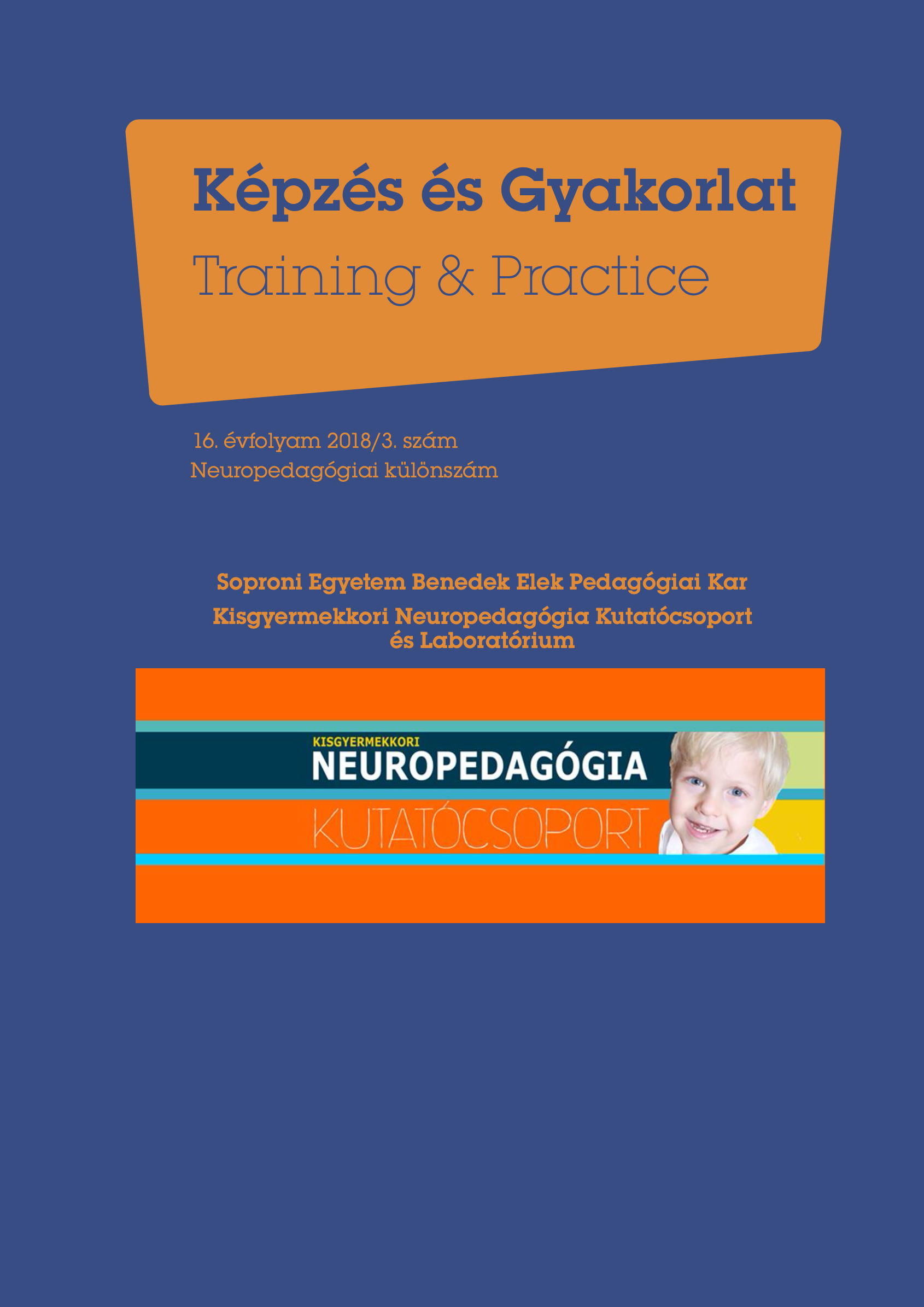Current Trends, Dilemmas and Future Directions in Neuropedagogy in the Field of Early Childhood
DOI:
https://doi.org/10.17165/TP.2018.3.6Kulcsszavak:
early childhood, neuroeducation, neuromyths, neuropedagogy, neuroeducational researchAbsztrakt
During the past 25 years, research on brain structure and function has expanded our understanding of the relationship between brain development and learning. This field of study is referred to with several terms such as neuroeducation, neuropedagogy, and Mind, Brain and Education. Although a strong interest in neuroeducation is present among researchers and teachers, often misleading recommendations from neuroscience research are made for classrooms. This article provides an overview of neuroeducational research studies in early childhood education to demonstrate how this field of study impacts teachers’ and parents’ understanding of best practices and optimal development. Also, to address the concern of the valid and reliable research in neuroeducation, we outline the principles of neuroeducational research based on Nouri (2016), and propose directions for future research.
Hivatkozások
Blair, C., & Raver, C. (2015). School readiness and self-regulation: A developmental psychobiological approach. Developmental Psychology, 66, 711-731. DOI: https://doi.org/10.1146/annurev-psych-010814-015221
Burdette, H., & Whitaker, R. (2005). Resurrecting free play in young children: Looking beyond fitness and fatness to attention, affiliation and affect. Archives of Pediatric and Adolescent Medicine, 159, 46-50. DOI: https://doi.org/10.1001/archpedi.159.1.46
Caffara, S. Martin, C., Lizarazu, M., Lallier, M., Zarrage, A., Molinari, N., & Carreiras, M. (2017). Word and object recognition during reading acquisition: MEG evidence. Developmental Cognitive Neuroscience. 24. 21-32. DOI: https://doi.org/10.1016/j.dcn.2017.01.002
Fletcher, K. (2011). Neuropsychology of early childhood. In A.D. Davis (Ed.), Handbook of pediatric neuropsychology (pp. 31-36). New York: Springer.
George, E. & Coch, D. (2011). Music training and working memory: An ERP study. Neuropsychology, 49(5). 1083-1094. DOI: https://doi.org/10.1016/j.neuropsychologia.2011.02.001
Haslip, M., & Gullo, D. (2018). The changing landscape of early childhood education: implications for policy and practice. Early Childhood Education Journal, 46. 249-264. DOI: https://doi.org/10.1007/s10643-017-0865-7
Hendricks, C.C. (2017). Improving schools through action research: A reflective practice approach. (4th ed). New York: Pearson.
Howard-Jones, P.A. (2010). Introducing neuroscience research: Neuroscience, education and the brain. New York: Routledge. DOI: https://doi.org/10.4324/9780203867303
Howard‐Jones, P. A. (2011). A multiperspective approach to neuroeducational research. Educational Philosophy and Theory, 43(1), 24-30. DOI: https://doi.org/10.1002/9781444345827.ch4
Hruby, G.G. & Goswani, U. (2011). Neuroscience and reading: A review for reading education researchers. Reading Research Quarterly, 46(2) 156-172. DOI: https://doi.org/10.1598/RRQ.46.2.4
Kraft, V. (2012) Neuroscience and education: Blind spots in a strange relationship. Journal of Philosophy of Education 46(3). 386-396. DOI: https://doi.org/10.1111/j.1467-9752.2012.00868.x
National Association for the Education of Young Children (2015). Developmentally appropriate practice and the common core state standards: Framing the issues. Washington, DC.: National Association for Education of Young Children.
Neville, H. Andersson, A., Bagdade, O., Bell, T. Currin.J. (2008). Effects of music training on brain and cognitive development in underprivileged 3 to5-year-old children: Preliminary results. Learning, arts, and the brain: The Dana Consortium Report on Arts and Cognition, the Dana Foundation. (pp. 105-106). New York.
Nouri, A., & Mehrmohammadi, M. (2012). Defining the boundaries for neuroeducation as a field of study. Educational Research Journal, 27(1). 1-25.
Nouri, A. (2016). The basic principles of research in neuroeducational studies. International Journal of Cognitive Research in Science, Engineering and Education. 4(1), 59-66. DOI: https://doi.org/10.5937/IJCRSEE1601059N [Retrieved from http://www.ijcrsee.com/index.php/IJCRSEE/article/view/41/60]
Patten, K.E. & Campbell, S.R. (eds.) (2011). Educational neuroscience. Educational Philosophy and Theory, 43(1). 1-6. DOI: https://doi.org/10.1002/9781444345827.ch13
Pasquinelli, E. (2012) Neuromyths: Why do they exist and persist. Mind, Brain and Education, 6. 89-96. DOI: https://doi.org/10.1111/j.1751-228X.2012.01141.x
Schwartz, M. & Gerlach, J. (2011). The birth of a field and rebirth of laboratory school. Educational Philosophy and Theory, 43(1), 67-74. DOI: https://doi.org/10.1111/j.1469-5812.2010.00709.x
Smeyers, P. (2016). Neurophilia: Guiding Educational Research and the Educational field? Journal of Philosophy of Education, 50(1), 62-75. DOI: https://doi.org/10.1111/1467-9752.12173
Szalavitz, M. & Perry, B. (2011). Born to love. New York: Harper Collins Publishers.
Tan, A. & Molfese, D. (2009). ERP correlates of noun and verb processing in preschool-age children. Biological Psychology, 80(1), 46-51. DOI: https://doi.org/10.1016/j.biopsycho.2008.04.014
Tobin, J. (2013). The disappearance of the body in early childhood education. In. L. Bresler (Ed.), Knowing bodies, moving minds: Towards embodied teaching and learning (pp. 111-126). New York, NY: Springer. DOI: https://doi.org/10.1007/978-1-4020-2023-0_8
Williams, K. E. (2018). Moving to the beat: Using music, rhythm, and movement to enhance self-regulations in early childhood classrooms. International Journal of Early Childhood, 50(1) 85-100. DOI: https://doi.org/10.1007/s13158-018-0215-y
Zambo, D. (2013). The practical and ethical concerns of using neuroscience to teach young children and help them self-regulate. In L. H. Wassreerman & D. Zambo (Eds). Early childhood and neuroscience- links to development and learning. (pp. 7-22). New York: Springer. DOI: https://doi.org/10.1007/978-94-007-6671-6
Zocchi, M. & Pollack, C. (2013). Educational neuroethics: A contribution from empirical research. Mind, Brain, and Education, 7(1), 56-62. DOI: https://doi.org/10.1111/mbe.12008
Letöltések
Megjelent
Folyóirat szám
Rovat
License
Copyright (c) 2018 Szécsi Tünde, Varga László, Mák Veronika

This work is licensed under a Creative Commons Attribution-NonCommercial-NoDerivatives 4.0 International License.








